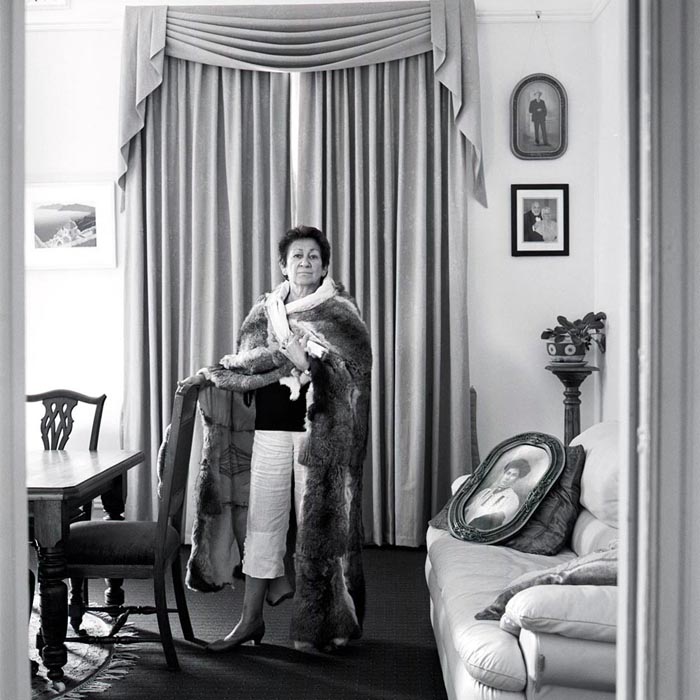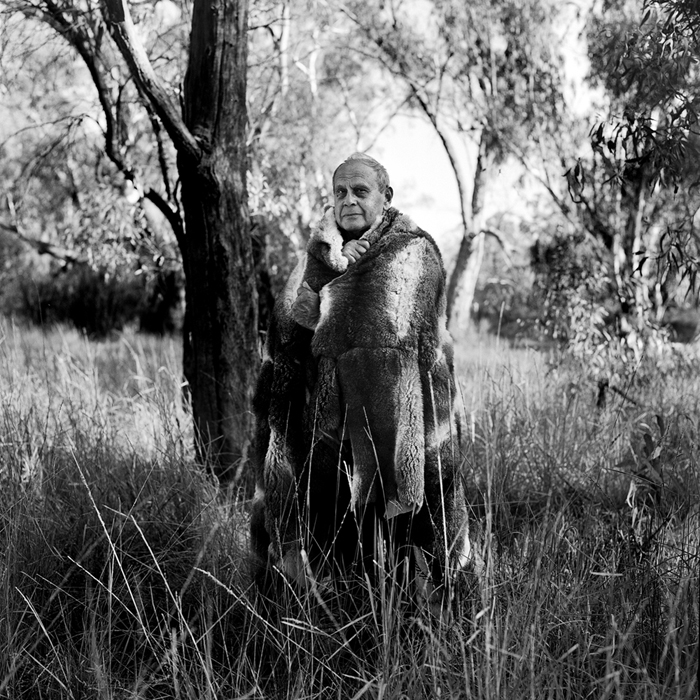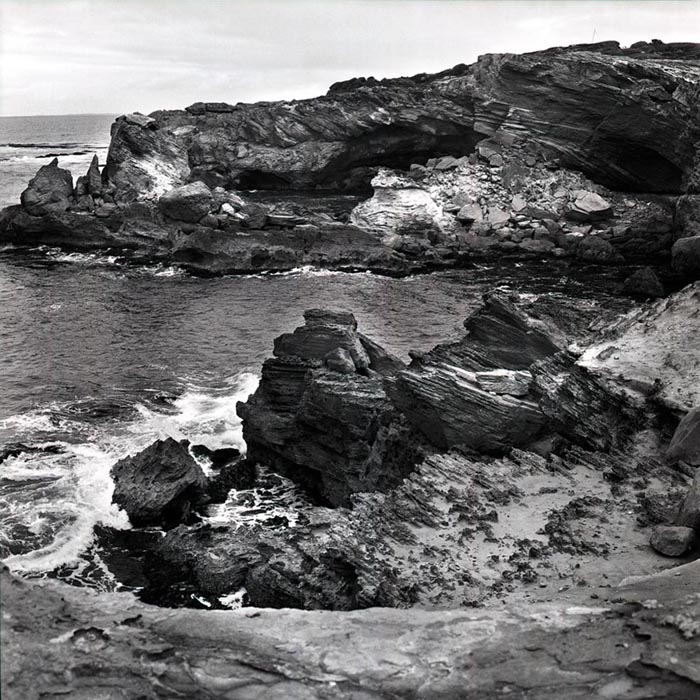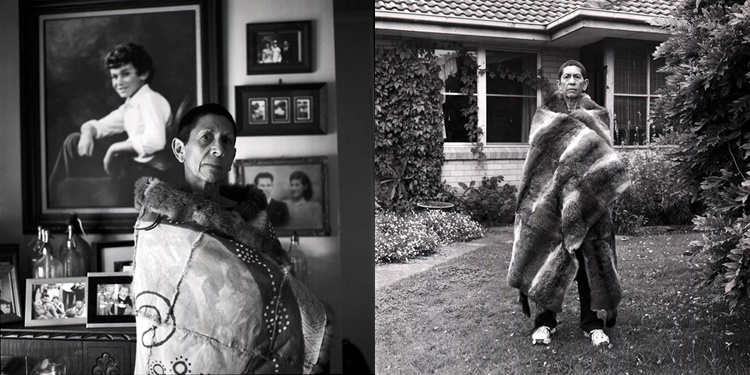SARAH RHODES
Home / On Country (2011 – 2013)
For centuries, every Aboriginal baby born in South-eastern Australia was wrapped in a possum skin marked with symbols telling the stories of its family and land. The cloak grew with the child. Pelts would be added to explain the child’s place in the tribe, map boundaries, places for good hunting and mark tribal laws. When the person died, the cloak became a burial shroud, depicting a full life story.
The possum skin cloak is a pictographic dictionary, a geographical map, an autobiography and an education tool.[1]
In this story, Sarah Rhodes photographs eight Victorian Elders and one from New South Wales at Home and On Country in cloaks that they either made or wore at the 2006 Melbourne Commonwealth Games Opening Ceremony.
Home / On Country (2011 – 2013) emphasises Aboriginal people’s connection to their land. How the soil they tread is as much part of their identity as the tapestry of decorated skins they sew. The pictures, presented as diptychs, also highlight the challenges in negotiating two cultures.
Melbourne artist Treahna Hamm (Yorta Yorta) and the Possum Women Maree Clarke (Mutti Mutti, Yorta Yorta), Vicki Couzens (Gunditjmara) and Lee Darroch (Yorta Yorta) were the force behind the revitalisation of the cloak-making tradition for the Games. They invited the communities in each of Victoria’s 36 language groups to make a cloak for an Elder to wear in the opening ceremony. These cloaks are now regularly used by the communities for Welcome to Country, baby namings, university graduations and funerals; and in schools as a teaching aid about Aboriginal culture.
The Games cloak project has been highly influential, inspiring a possum skin cloak-making movement full of energy and passion. The Possum Women run workshops across Victoria, NSW and South Australia to facilitate spiritual healing and to support the continuation of this traditional practice.
Traditionally, cloaks were made in South-eastern Australia (from northern NSW down to Tasmania and across to the southern areas of South Australia and West Australia), where there was a cool climate and abundance of possums. From the 1820s, when Aboriginal people started living on missions, they were no longer able to hunt and were given blankets for warmth. The blankets, however, did not provide the same level of waterproof protection as the cloaks.
There are few original cloaks remaining. A Gunditjmara cloak from Lake Condah and a Yorta Yorta cloak from Maiden’s Punt, Echuca, are held in Museum Victoria’s collection. Reproductions of these cloaks are held at the National Museum of Australia. A number of international institutions also hold original cloaks, including: the Smithsonian Institute (Washington DC), the Museum of Ethnology (Berlin) and the British Museum (London).
Home and On Country: Boonwurrung Elder Carolyn Briggs, 2011
Carolyn Briggs champions the role of Indigenous cuisine in maintaining health and well-being. She recently closed the doors of her restaurantTjanabi, in Federation Square, Melbourne, where Prime Minister Julia Gillard entertained United States Secretary of State, Hillary Clinton, in November 2010. The menu was based on Aboriginal people’s six seasons and their traditional way of eating organic, locally grown food.
As a language specialist and respected Boonwurrung Elder, Aunty Carolyn oversaw the design of the Boonwurrung and Wemba Wemba cloaks made for the Opening Ceremony of the 2006 Melbourne Commonwealth Games.
Carolyn Briggs travelled to her Country on the Mornington Peninsula to take time to practice deep listening. She believes her people need to research where they came from, know who their ancestors are, their language and understand what it means to be Aboriginal. As a language specialist and respected Boonwurrung Elder, Aunty Carolyn oversaw the design of the Boonwurrung and Wemba Wemba cloaks made for the Opening Ceremony of the 2006 Melbourne Commonwealth Games.
Home and On Country: Gunditjmara Elder Ivan Couzens, 2011
Gunditjmara Elder Ivan Couzens surrounds himself with photographs of his grandchildren and Richmond AFL souvenirs in his Warrnambool townhouse. Even though he spent his early years on the Framlingham Mission and schooled his children in the city of Warrnambool, he has always identified strongly with his Country in the Western District of Victoria.
As a respected cultural leader, he wore the Djargurd Wurrong cloak at the Opening Ceremony of the 2006 Melbourne Commonwealth Games. The cloak was made by his daughter Vicki Couzens and grand-daughters Yarran, Jarrah, Marlee, Niyoka and Kirrae Bundle.
Uncle Ivan, known for his prowess on the football field, stands proud and strong on Thunder Point overlooking Bass Strait. He has spent his life devoted to the Western District, championing stories about his Old People and actively keeping his ancestor’s language alive. He compiled the Keerray Woorrong and related dialects dictionary, published by the Victorian Aboriginal Corporation for Languages (VACL) in 1996. Uncle Ivan enjoys sharing stories about his ancestors, which inspired his daughters Vicki and Debra Couzens to start the possum skin cloak movement with Lee Darroch, Treahna Hamm and Maree Clarke.
Home and On Country: Baraparapa Elder Esther Kirby, 2011
Esther Kirby uses her art to bridge the cultural divide between traditional and contemporary life and is passionate about keeping her culture alive. She consults on Koorie culture and heritage for native title and works closely with young people in her community. She was quoted in The Australian on March 22, 2011 after shaking Prince William’s hand with pride. The young royal was visiting Kerang after the devasting floods. Esther said: “I think he is fantastic … He is his mother’s son. I think – a new generation”. Born in Balranald to a family of 13 children, Esther and her sister Phoebe Nicholson grew up on a mission and later moved along the Murray River to Kerang, near Swan Hill.
In her role as a Baraparapa Elder, Aunty Esther worked with her community to decide what stories would be told on the cloak about their Country. As the artist, she was responsible for expressing those stories through her own designs. The community was given permission to make the cloak by Elders: Damien Murray, Lillian Murray and John Charles.
Esther’s sister, Phoebe Nicholson, made the Wadi Wadi cloak for the opening ceremony of the Games.

Home: Wergaia Elder Professor Eleanor Bourke
Wergaia Elder Professor Eleanor Bourke has dedicated her career to fighting for Aboriginal rights in her roles with the Victorian Aboriginal Heritage Council and Native Title Services Victoria. She never lived on Country but was lucky enough to be raised by her grandmother, Eleanor Pepper, who told her stories about her Aboriginal culture.
Eleanor Bourke and her sister wanted to make the Wergaia cloak to wear to the Opening Ceremony of the 2006 Melbourne Commonwealth Games. The Wergaia community gave them their blessing but did not want to participate due to the politics around animal rights activism. Eleanor believed her language group had to be represented at the Games as they had been denied their existence for so long. She wore the cloak with pride at the Melbourne Cricket Ground – a place once used for corroborees.
She is the proprietor of the Mount Noorat Hotel, near Warrnambool. The pelican is a family totem, so she has pelican sculptures watching over her and bringing good luck.

Home: Taungurung Elder Mick Harding, 2011
Mick Harding did not know he was Aboriginal for the first 25 years of his life. When he discovered his Aboriginality, he began trying to understand what it means through his art-making. He is actively involved in the Australian Heritage Council (AHC) and Native Title Services Victoria (NTSV). Most importantly, he is sharing his research and knowledge with his children.
As a Taungurung Elder, Mick was the lead artist in designing the motifs on the Taungurung cloak. He held community workshops where stories were told and it was decided that each panel of the cloak would represent a creation story.

On Country: Yorta Yorta Elder Professor Henry Atkinson
Professor Henry Atkinson, spokesperson for the Yorta Yorta Council of Elders, was raised in Echuca and has strong ties to his Country. When the Yorta Yorta people lost their native title claim, it made him all the more determined to reclaim their culture and rights. Uncle Henry is acutely aware of how difficult it is for Indigenous people in South-east Australia to be recognised as Aboriginal people compared with those in Alice Springs, where his adoptive family live.
He recently retired as a professor of education at Monash University. His role was to show teachers ways to connect with Aboriginal students so they can receive the best education. He wants young Indigenous Australians to strive to be role models for the next generation – to work in business, law and medicine.
The Yorta Yorta community at Echuca made the cloak with the support of artist Treahna Hamm. Uncle Henry wore the Yorta Yorta cloak at the Opening Ceremony of the 2006 Melbourne Commonwealth Games.
Home: Wemba Wemba Elder Fay Muir, 2011
Fay Muir works with the Victorian Aboriginal Corporation for Languages, teaching juveniles in detention.
She was the lead artist for the Wemba Wemba cloak and wore it at the Opening Ceremony of the 2006 Melbourne Commonwealth Games. Aunty Fay worked under the cultural guidance of Boonwurrung Elder, Carolyn Briggs. She lives in Geelong.
Home and On Country: Wadi Wadi Elder Phoebe Nicholson, 2011
An artist in her own right, Wadi Wadi Elder Phoebe Nicholson works as a teacher’s aid at the Victorian College of Koori Education (Payika Campus), Swan Hill. Aunty Phoebe is passionate about the Murray River. It is a source of inspiration for her art and a place to take her children camping at Christmas time. She worked with her son and daughter, and her community, to tell contemporary stories about the country of the Wadi Wadi language group on her possum skin cloak. Phoebe’s sister, Esther Kirby, made the Baraparapa cloak for the opening ceremony.

BIOGRAPHY
Sarah works as an art and social documentary photographer and has taken delightful journeys into the lives of others. She works as a photojournalist for The Visual Storyteller, has produced an illustrated book The Artist’s Lunch and investigates themes of identity in her art practice. Sarah’s photographs and writing are published in print and online journals and she is also co-editor of Timemachine Magazine.
Sarah will also be exhibiting the Home / On Country (2011-2013) series at the Albury City Library Museum from Saturday 30 March 2013 to Sunday 12 May 2013. The show opens on April 6 at 2pm. More details can be found here.
More of Sarah’s work can be viewed on her website and for more information regarding this series pelase visit: http://www.cv.vic.gov.au/stories/possum-skin-cloaks/






